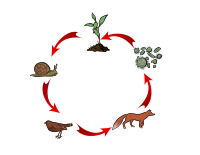Autotrophic nutrition
Autotrophic nutrition is the ability of certain organisms to synthesize all the essential substances for their metabolism from inorganic substances, so that they do not need other living beings for their nutrition. Autotrophic organisms They are plants, algae and some bacteria and archaea.
They are called this way because they generate their own food, through inorganic substances for their metabolism. Autotrophic organisms produce their cell mass and organic matter from carbon dioxide, which is inorganic, as the only carbon source, using light or chemicals as an energy source.
Autotrophs can be classified as photosynthetic and chemosynthetic. Plants and other organisms that use photosynthesis are called photolithoautotrophs; Bacteria that use the oxidation of inorganic compounds, such as sulfur dioxide or ferrous compounds, to produce energy are called chemolithotrophs.
Heterotrophs, such as animals, fungi, protozoa, slime molds, and most bacteria and archaea, depend on autotrophs as they use the matter they contain to make complex organic molecules.
Types
Living things base their composition on compounds in which the defining chemical element is carbon (organic compounds), and autotrophs obtain all their carbon through a metabolic process of carbon fixation called the Calvin cycle.
Ecological homework
Autotrophic organisms form the first link in trophic chains as primary producers of the organic matter that circulates through them. They are necessarily the most abundant organisms, since, given the limited efficiency of metabolic processes, each link it is much less represented than the previous ones.
Autotrophs are an essential part of the food chain, since they benefit other living things, called heterotrophs, which use autotrophs for food. Autotrophs get the atoms and energy they need from abiotic sources, such as sunlight (through photosynthesis) or chemical reactions between mineral substances (through chemosynthesis), as well as from inorganic sources, such as carbon dioxide. carbon, and convert them into organic molecules that they use to carry out biological functions, such as their own cell growth, as well as serving as food for heterotrophs.

